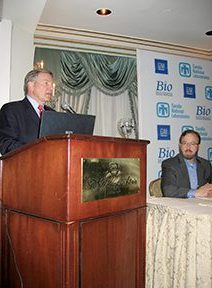
At a press conference in New York City on Feb. 10, General Motors and Sandia announced that biofuels made from plants, forestry waste, and dedicated energy crops could sustainably replace nearly a third of US gasoline usage by 2030. The announcement was made at the Biotechnology Industry Organization (BIO) CEO & Investor Conference.
Bob Carling, director of Transportation Energy Center 8300, presented the results of the GM-funded “90 Billion Gallon Biofuel Deployment Study.” The goal was to assess if and how a large volume of cellulosic biofuel could be sustainably produced, processed, and delivered assuming technical and scientific progress continues at expected rates. The study was conducted at Sandia and GM over a period of nine months.
“This wasn’t just GM coming to us to ask us to do a study for them,” said Bob at the news conference, “but instead it was a teaming opportunity where we were able to collectively address a critical national need alongside our GM partners.”
Sandia and GM researchers examined the interdependencies of land, water, infrastructure, workforce, economic, technology, and environmental factors and assessed the feasibility, implications, limitations, and enablers of annually producing 90 billion gallons of ethanol — sufficient to replace more than 60 billion of the estimated 180 billion gallons of gasoline expected to be used annually by 2030. Ninety billion gallons a year exceeds DOE’s goal for ethanol production established in 2006.
“In this study, Sandia leveraged its systems analysis expertise to develop a framework for open and transparent decision making,” says Terry Michalske, director of Energy Innovation Initiatives Center 6100. “This approach will prove invaluable in supporting investment and policy decision making and in helping to monitor and assess progress going forward.”
The 90 Billion Gallon Study assumes that 75 billion gallons would be ethanol made from nonfood cellulosic feedstocks and 15 billion gallons from corn-based sources. The study examined four sources of biofuels: agricultural residue, such as corn stover and wheat straw; forest residue; dedicated energy crops, including switchgrass; and short-rotation woody crops, such as willow and poplar trees. It examines the costs of producing, harvesting, storing, and transporting these sources to newly built biorefineries.
Using a newly developed tool known as the Biofuels Deployment Model, or BDM, Sandia researchers determined that 21 billion gallons of cellulosic ethanol could be produced each year by 2022 without displacing current crops. The Renewable Fuels Standard, part of the 2007 Energy Independence and Security Act, calls for ramping up biofuels production to 36 billion gallons a year by 2022.
The 90 Billion Gallon Study, which focused only on starch-based and cellulosic ethanol, found that an increase to 90 billion gallons of ethanol could be sustainably achieved by 2030 within real-world economic and environmental parameters.
Other findings:
- The domestic investment for biofuels production is projected to be virtually the same as the investment required to sustain long-term domestic petroleum production.
- Policy incentives such as a federal cap and trade program, carbon taxes, excise tax credits, or loan guarantees for cellulosic biofuels are important to mitigate the risk of oil market volatility.
- Cellulosic biofuels could compete without incentives with oil priced at $90 per barrel, assuming a reduction in total costs as advanced biofuels technologies mature.
- Continued support of R&D and initial commercialization is critical because sustained technological progress and commercial validation is a prerequisite to affordably producing the large volumes of ethanol considered in this study.
- Large-scale cellulosic biofuel production could be achieved at or below current water consumption levels of petroleum fuels from on-shore oil production and refining.
The industrial processes by which nonfood forms of biomass are converted into sugars suitable for production of biofuels were a focus of the study.
Sandia’s analysis also included land use, water availability, energy used to produce cellulosic biomass, transportation of feedstocks, and other potential leverage points for the development and use of cellulosic biofuels. In conducting its research, Sandia utilized models that examined current and future technologies for development of ethanol.
Future enhancements to Sandia’s BDM are planned, contingent on additional partnerships. Such improvements to the current software tool, says Carrie Burchard, from Business Development Support Dept. 8529, would provide an even more comprehensive systems understanding of the biofuels industry.
Sandia enjoys a longstanding relationship with all the major US automakers and engine manufacturers, and has worked previously with GM on a variety of automotive research activities. Sandia also plays a major role in the Joint BioEnergy Institute (JBEI) and several other transportation energy and biofuels projects.
An executive summary of the 90 Billion Gallon Biofuel Deployment Study can be found at www.hitectransportation.org.
Larry Burns, GM’s VP for Research & Development and Strategic Planning, in remarks at the news conference put the Sandia/GM work in real-world perspective: “If you really want to impact imported oil and move the needle quickly, there’s nothing more attractive than biofuels in the automotive sector.”